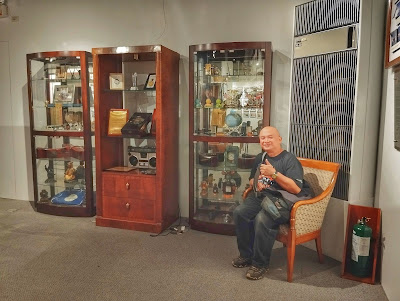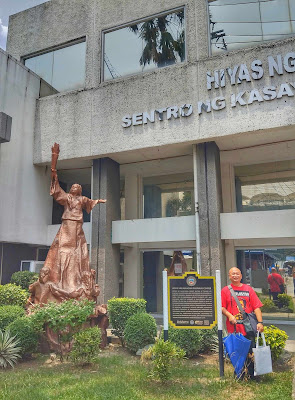Situated in Central Luzon, the Province of Bulacan has always been a mecca as far as events in Philippine history is concerned, as clearly evidenced by the numerous local holidays, connected to either key historical figures or events, which shaped our nation to what it is right now.
Due to this fact, it would not be surprising if heritage enthusiasts continuously flock towards this tourist destination, especially during the dry season.
Way back May 2023, the Provincial History, Arts, Culture, and Tourism Office (PHACTO) at the Hiyas ng Bulacan Cultural Center in Malolos, Bulacan, launched the so-called "Bulacan Pamana Pass", which allowed participants the opportunity to visit 20 heritage structures in the province.
Successfully generating a good following on this tourism-related undertaking, last June 2025, PHACTO then released the second installment aptly entitled the “PASS-yal Museo Bulacan Pamana Pass”, focusing now on 24 various old and modern museums in Bulacan, worth taking into account.
 |
| PASS-yal Museo Bulacan Pamana Pass |
For those who want to experience this new journey, the mechanics of which is that, for every designated museum within a given municipality, make sure that the Pass be officially stamped on-site.
Do acquire your free Pamana Pass at the following venues: Hiyas ng Bulacan Museum (Malolos), Museo de San Miguel (San Miguel), NHCP Museo ni Mariano Ponce (Baliwag), Museo de Pulilan (Pulilan), NHCP Museo ni Marcelo H. del Pilar (Bulakan), and Museo ng Pamanang Meycaueño (Meycauayan). Better to contact your preferred venue first to make sure if they still have available passports in stock, as well as their operating days/hours.
Anyway, my group, the Larga-Bistas, began our trip last July 2, 2025 and ended August 7, 2025. We all come from Malabon, Cavite, Mandaluyong, and Quezon City.
Here was the chronological order on how we finished the “PASS-yal Museo Bulacan Pamana Pass” journey.
Museum #1: Museo de San Miguel (San Miguel)
The museum is a repository of old artifacts, documents, sculptures, and objects of religious, cultural, and historical value about the Municipality of San Miguel that educate and inspire its faithful.
 |
| Museo de San Miguel |
Museum #2: Pambayang Museo ng Bustos (Bustos)
A cultural center dedicated to promoting knowledge, history, and the arts in the town of Bustos.
 |
| Pambayang Museo ng Bustos |
Museum #3: Museo ni Mariano Ponce (Baliwag)
Built on the birthplace of Mariano Ponce, who managed the reformist periodical “La Solidaridad”, the museum presents his extraordinary life and achievements.
 |
| Museo ni Mariano Ponce |
Museum #4: Museo ng Baliwag (Baliwag)
Due to ongoing maintenance of the actual museum, as of this posting, participants could only pose next to a pocket exhibit inside the Tanggapan ng Sining, Kultura, at Turismo within the Baliwag Business Center Complex.
 |
| Museo ng Baliwag |
 |
| Museo ng Baliwag (2024 Photo) |
Museum #5: Museo Central ng Pulilan (Pulilan)
Established in 2024, this reconstructed 1919 Post-Gabaldon building-turned-museum showcases the history and heritage of Pulilan Central School using old documents, photos, memorabilia, and artworks.
 |
| Museo Central ng Pulilan |
Museum #6: Museo San Ysidro de Pulilan (Pulilan)
Founded in 1997, the museum comprises artifacts, memorabilia, photographs, and documents, most of which are ecclesiastical, like the century-old scriptures of saints.
 |
| Museo San Ysidro de Pulilan |
Museum #7: Museo de Pulilan (Pulilan)
Restored in 2013, this 1908 Gabaldon building-turned-museum serves as a repository of Pulilan’s historical and cultural materials, and promotes the town’s local history.
 |
| Museo de Pulilan |
Museum #8: Museo ni Marcelo H. del Pilar (Bulakan)
The museum located at the birthplace of Marcelo H. del Pilar contains various galleries related to the life of del Pilar. His remains can also be found inside the compound.
 |
| Museo ni Marcelo H. del Pilar |
Museum #9: Museo de Parroquia de Nuestra Señora de la Asuncion (Bulakan)
Located inside the second oldest church in the Province of Bulacan, the museum houses two sections: (1) the Oratorio ng Nuestra Señora de la Asuncion, and (2) the Museo ng Kasaysayan at Arkibo ng Simbahang Naglalakbay at ng Bayan ng Bulakan.
 |
| Oratorio ng Nuestra Señora de la Asuncion |
 |
| Museo ng Kasaysayan at Arkibo ng Simbahang Naglalakbay at ng Bayan ng Bulakan |
This houses Filipiniana Collection dedicated to our national heritage, which is owned by Bulacan historian and academician Jaime Salvador Corpuz.
 |
| Bahay Makabayan |
Museum #11: Pulong Kabyawan (Pulilan)
This is the first-ever protected, community-based, agri-ecotourism heritage zone located in Barangay Inaon, Pulilan, Bulacan.
 |
| Pulong Kabyawan |
Museum #12: Parola Museum (Plaridel)
The first museum in Plaridel offers history and verdant views in a modern setting. It displays the Parulan history, notable Paruleños, World War II Parulan Veterans, and the life of Commodore Ramon Alcaraz.
 |
| Parola Museum |
 |
| View on top of the Lighthouse |
Museum #13:Museo ni San Andres Kim Taegon (Bocaue)
Situated at the place where the first Catholic priest in South Korea stayed in the Philippines, the museum houses various historical aspects on the life of Saint Andrew Kim Taegon.
 |
| Museo ni San Andres Kim Taegon |
Museum #14: Museo ng Pamanang Meycaueño (Meycauayan)
Established in 2022, the museum contains materials related to Meycauayan history, tradition, heritage, arts, and culture.
 |
| Museo ng Pamanang Meycaueño |
Museum #15: Arkeolohiya sa Kaligiran ng Biak-Na-Bato (San Miguel/Doña Remedios Trinidad)
The museum is an exhibition and representation of the history, archaeology, and diversity of the Biak-Na-Bato National Park.
 |
| Arkeolohiya sa Kaligiran ng Biak-Na-Bato |
Museum #16: Bocaue Institute for History and Information (Bocaue)
Dr. Yanga's Colleges Inc. (DYCI)-BINHI is an interactive Learning Center for Bocauenos that envisions to provide a deeper understadning and appreciation of the history, religiousity, arts, and culture of Bocaue, Bulacan.
 |
| Bocaue Institute for History and Information |
Museum #17: Museo ni Maria (Santa Maria)
Built in 2018 in honor of the Patroness, La Purisima Concepcion, for devotees, the “Museo ni Maria” holds a vast collection of vestments, jewelry, and antique pieces of the Virgin.
 |
| Museo ni Maria |
Museum #18: Museo de Marileño (Marilao)
Opened in 2024, the museum displays old household items, photos of leaders and notable personalities from Marilao, as well as other memorabilia and collections.
 |
| Museo de Marileño |
Museum #19: Museo de la Parroquia (Obando)
The museum showcases the cultural treasures that shaped that shaped and formed the spiritual and communal life of the people of Obando from the establishment of the Parish of San Pascual in 1754 up to the present.
 |
| Museo de la Parroquia |
Museum #20: Museo ng Kasaysayang Pampulitika ng Pilipinas (Malolos)
Located at the Malolos Casa Real, the exhibits trace the evolution of the Filipino nation-state and the emergence of its system of government and democratic traditions amid the backdrop of long struggles for independence.
 |
| Museo ng Kasaysayang Pampulitika ng Pilipinas |
Museum #21: Museo ng Republika ng 1899 (Malolos)
Housed inside the convent of the historic Barasoain Church, the museum contains historical photographs of Bulacan and different rooms relate how democracy was established in the country.
 |
| Museo ng Republika ng 1899 |
Museum #22: Bulacan Cultural Material Laboratory (Malolos)
Located inside the Bulacan State University is a research laboratory that develops and applies scientific methods to the study and preservation of important cultural materials.
 |
| Bulacan Cultural Material Laboratory |
Museum #23: Hiyas ng Bulacan Museum (Malolos)
Located inside the Hiyas ng Bulacan Convention Center is a museum featuring galleries narrating the history of the Province of Bulacan.
 |
| Hiyas ng Bulacan Museum |
Museum #24: La Casa Azul: The Nava Cruz Gallery (Calumpit)
Conceptualized by an OFW writer working in the Kingdom of Saudi Arabia, this museum, the first “Filipino-Arabian Cultural & Heritage Home” in Calumpit, showcases collections from different parts of the world.
 |
| La Casa Azul: The Nava Cruz Gallery |
Awarding of Tokens and Certificates (Malolos)
Hiyas ng Bulacan Cultural Center in Malolos, Bulacan on August 7, 2025.
 |
| Posing with PHACTO Officers |
The main challenge in completing the “PASS-yal Museo Bulacan Pamana Pass,” would be aside from the traffic and weather, on how the participant could make himself available in order to visit each museum because each venue has its own scheduled days and times of operation.
Nevertheless, the whole experience was so worth the effort for the entire group, since this tourism-related undertaking allowed us to "forcibly" travel towards various destinations, wherein several of them, we have not visited yet, as well as basic historical know-how were printed on the Pass, which greatly added to our knowledge, and lastly, the priceless conversations with local museum guides, which added more flavor towards the journey.
Hats off to all those who have spearheaded this type of project…again. Kudos!
More reasons indeed na babalik-balikan ang lalawigan ng Bulacan. Explore Pinas!


































